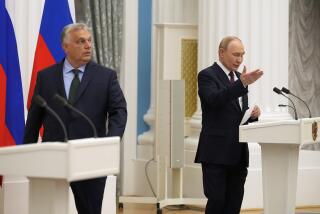When Hungary led the way
- Share via
The breaching of the Berlin Wall 20 years ago this month has become the symbol of the collapse of communism in Eastern Europe and, ultimately, the triumph of democracy. But sometimes I wonder if we actually know yet what we were witnessing.
I didn’t see the wall come down, but I was in Hungary eight months earlier for what was in retrospect the beginning of the end of the Soviet system. At the time, we didn’t know what we were seeing, but on March 15, 1989, I was part of a team from the “MacNeil/Lehrer NewsHour” on PBS, filming a crowd of demonstrators estimated at 100,000 who had flooded into the square that housed Magyar Televizio, Hungarian state television in Budapest. The people were carrying Hungarian flags and were there to deliver a petition demanding democratic rights.
It was a far cry from the Budapest I’d reported on just two years earlier, when it seemed as if the Soviet presence in Eastern Europe would last for a thousand years. The U.S. Embassy was then one of the most heavily bugged structures in Budapest, so when we went there to interview embassy personnel, we talked about the weather, carrying on our actual communication by passing notes. When we interviewed dissidents on that trip, they took great pains to keep the meetings secret. Among the few people who dared to say anything mildly challenging against the regime were a group of university students who spread a blanket on the lawn of their school and talked on camera about having read George Orwell’s anti-authoritarian novel, “1984.”
By 1989, when I returned, everything had changed. When I visited that same embassy the first week of March, a U.S. official talked openly to us -- and presumably to the KGB eavesdroppers -- about how, as the impending March 15 demonstration seemed to get bigger, Soviet leader Mikhail Gorbachev was not responding to pleas for instruction from Hungary’s communist rulers. “We don’t know what to make of it,” he said. Dissidents nonchalantly joined me for dinner in the restaurant of my hotel, the most prominent in town. And the people planning the March 15 demonstration -- a coalition of traditional dissidents, mildly oppositional academics and students -- held their sessions in the basement of a well-known restaurant and allowed us to videotape their strategizing.
Among the boldest of the demonstration planners were a group of students, including those we’d interviewed two years earlier, who’d formed a political movement called the Young Democrats. They told us they were determined to make a stand while they were young, because by the time Hungarians reached their mid-20s, the regime had usually co-opted them.
Still, the outcome was not certain. This was Hungary, after all, where in 1956 the Soviet Union had brutally put down a revolt against the regime that began when demonstrators surrounded Hungarian state radio.
On March 15, as we videotaped from the steps of Magyar Televizio, some people carried a list of demands for democracy up out of the crowd. The door of the television station opened, and the list was accepted. That evening, it was read on the news. Tens of thousands of people marched peacefully through the city. The world was changing as we watched, but we didn’t report that the Iron Curtain had torn open, because we had no idea that it had.
It all began to come into clearer focus two months later, when Hungary removed the barbed-wire fence along its border with Austria and told guards not to shoot those who wanted to cross. Months after that, the Berlin Wall fell, and two years later the Soviet Union dissolved, albeit with fewer memorable images. Before the decade was out, Viktor Orban, one of the mildly rebellious students whom we’d interviewed in 1986, had become prime minister of Hungary.
In retrospect, some things that seemed puzzling at the time now seem so clear. The embassy wondered why Gorbachev was ignoring the Hungarian leaders’ plea for assistance. But as it turned out, his not responding was central to all that happened next. Months later, he also didn’t take the calls from panicky East Germans seeking guidance for how to react when the wall was breached. He had decided to disengage, and that made all the difference.
It’s also clear, two decades later, that the end of the Cold War left a power vacuum in the world. No longer was it necessary for countries to affiliate themselves with one superpower or the other. But once the world no longer fell obediently into zones of either Soviet or U.S. control, control was harder to impose. Think Afghanistan.
Since the end of the Cold War, new powers, such as China and India, seem to be rising, based on their increasing power in the world economic system. But it’s not entirely clear what it all will mean.
When Eastern Europe emerged from Soviet domination 20 years ago, it seemed as if they were joining us, but in retrospect, we all may have been joining something else that is pulling us along. Exactly what that is, we can’t yet see.
More to Read
Sign up for Essential California
The most important California stories and recommendations in your inbox every morning.
You may occasionally receive promotional content from the Los Angeles Times.













